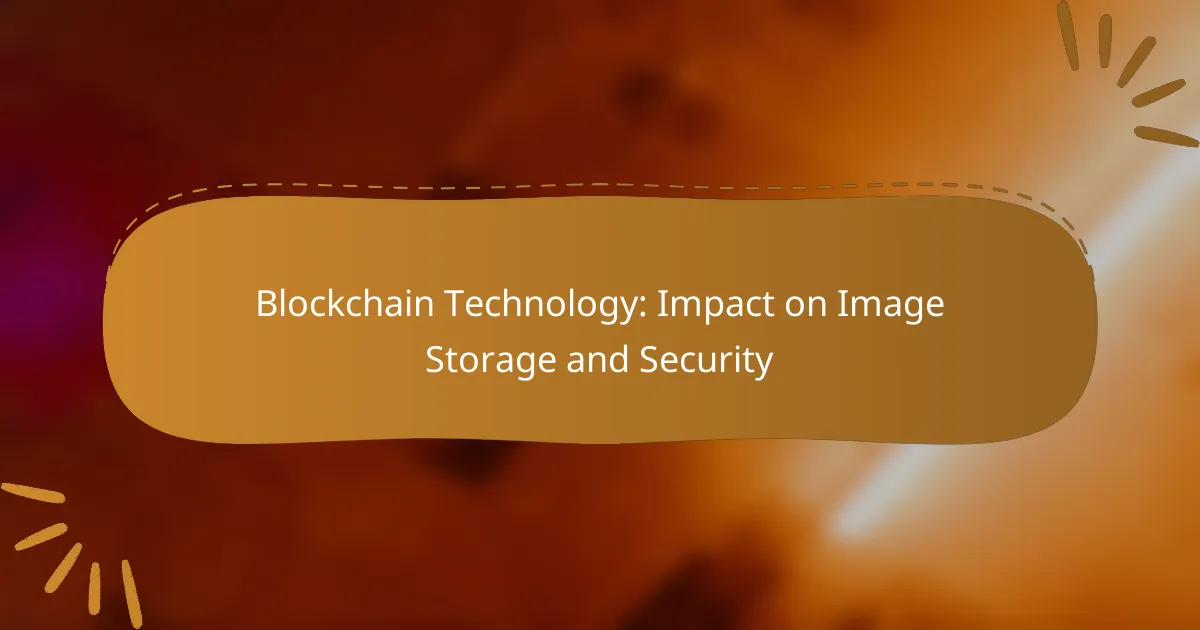Blockchain technology is revolutionizing image storage by providing a secure, decentralized framework that safeguards digital assets against unauthorized alterations and data breaches. By leveraging this tamper-proof system, users can ensure their images are reliably stored and easily verifiable, enhancing both security and transparency in digital asset management.

How does blockchain technology enhance image storage security?
Blockchain technology enhances image storage security by providing a decentralized and tamper-proof system for managing digital assets. This approach ensures that images are securely stored, verified, and accessed, reducing the risk of unauthorized alterations and data breaches.
Decentralized storage solutions
Decentralized storage solutions distribute image data across multiple nodes rather than relying on a single server. This reduces the risk of data loss or corruption, as there is no central point of failure. Users can access their images from various locations, ensuring greater availability and resilience.
For example, platforms like IPFS (InterPlanetary File System) allow users to store images in a distributed manner, making it difficult for malicious actors to manipulate or delete files. This model not only enhances security but also promotes redundancy and reliability in image storage.
Immutable data verification
Blockchain’s immutable nature ensures that once an image is stored, its data cannot be altered without detection. Each image is linked to a unique hash, creating a digital fingerprint that verifies its authenticity. This feature is crucial for industries that require proof of originality, such as art and photography.
By utilizing smart contracts, users can automate the verification process, ensuring that any attempt to modify an image triggers alerts. This level of security is particularly valuable in protecting intellectual property and maintaining the integrity of digital content.
Enhanced access control
Blockchain technology allows for sophisticated access control mechanisms, enabling users to define who can view or modify their images. Through cryptographic keys, only authorized individuals can access specific files, significantly reducing the risk of unauthorized access.
For instance, a photographer can share an image with a client while retaining ownership rights, ensuring that the image cannot be used without permission. This level of control is essential for maintaining privacy and protecting sensitive information in a digital landscape.

What are the benefits of using blockchain for image storage?
Using blockchain for image storage offers enhanced security, transparency, and reliability. By leveraging decentralized technology, users can ensure their images are securely stored and easily verifiable without relying on a single point of failure.
Increased transparency
Blockchain technology provides a transparent ledger where every transaction related to image storage is recorded. This means that users can trace the history of an image, including its creation, modifications, and ownership transfers, ensuring authenticity.
For example, artists can prove their ownership and the originality of their work, which is crucial in preventing copyright infringement. This transparency fosters trust among users and stakeholders in the digital image ecosystem.
Reduced risk of data loss
Storing images on a blockchain minimizes the risk of data loss due to its decentralized nature. Unlike traditional storage methods that can be vulnerable to server failures or cyberattacks, blockchain distributes data across multiple nodes, ensuring redundancy.
In practical terms, this means that even if one node goes offline, the image data remains accessible from other nodes. Users can feel more secure knowing their images are less likely to be lost or corrupted over time.
Improved data integrity
Blockchain enhances data integrity by using cryptographic techniques to secure images and their metadata. Each image is hashed and linked to its previous version, creating an immutable record that cannot be altered without detection.
This integrity is vital for applications such as medical imaging or legal documentation, where accurate records are essential. Users can trust that the images stored on a blockchain are genuine and have not been tampered with, providing peace of mind in critical situations.

How can businesses implement blockchain for image storage?
Businesses can implement blockchain for image storage by selecting a suitable platform, integrating it with existing systems, and training staff on its usage. This approach enhances security, ensures data integrity, and provides a decentralized method for managing image files.
Choosing the right blockchain platform
Selecting the right blockchain platform is crucial for effective image storage. Consider factors such as scalability, transaction speed, and security features. Popular options include Ethereum, Hyperledger, and IPFS, each offering unique advantages depending on the business’s specific needs.
Evaluate the costs associated with each platform, including transaction fees and maintenance expenses. A platform that supports smart contracts may also provide additional functionality for automating processes related to image management.
Integrating with existing systems
Integrating blockchain technology with existing systems requires careful planning. Businesses should assess their current infrastructure and identify how blockchain can complement or replace existing image storage solutions. This may involve using APIs or middleware to facilitate communication between systems.
Conduct a pilot project to test the integration before full deployment. This approach helps identify potential issues and ensures that the blockchain solution works seamlessly with current workflows.
Training staff on blockchain usage
Training staff on blockchain usage is essential for successful implementation. Employees need to understand how to interact with the new system, including uploading, retrieving, and managing images on the blockchain. Consider offering workshops or online courses to build competency.
Encourage a culture of continuous learning, as blockchain technology evolves rapidly. Providing ongoing support and resources will help staff stay updated on best practices and new features related to image storage on the blockchain.

What are the challenges of blockchain in image storage?
Blockchain technology faces several challenges in image storage, primarily related to scalability, energy consumption, and regulatory compliance. These issues can hinder the efficiency and practicality of using blockchain for managing image data.
Scalability issues
Scalability is a significant challenge for blockchain in image storage, as the size of image files can be substantial. Traditional blockchains may struggle to accommodate large volumes of data, leading to slow transaction times and increased costs. Solutions like off-chain storage or layer-2 protocols are being explored to mitigate these limitations.
For example, storing image metadata on the blockchain while keeping the actual images on a centralized server or a decentralized file system can enhance scalability. This hybrid approach allows for faster access and lower storage costs while maintaining the integrity of the image data.
High energy consumption
High energy consumption is another critical concern associated with blockchain technology, particularly for proof-of-work systems. The energy required to validate transactions and maintain the network can be significant, raising environmental and cost-related issues. This is especially relevant in regions where energy costs are high or where sustainability regulations are strict.
To address this, many blockchain projects are shifting towards more energy-efficient consensus mechanisms, such as proof-of-stake. These alternatives can reduce energy usage dramatically while still providing secure and reliable image storage solutions.
Regulatory compliance concerns
Regulatory compliance is a vital consideration for blockchain in image storage, as different jurisdictions have varying laws regarding data protection and privacy. For instance, regulations like the General Data Protection Regulation (GDPR) in Europe impose strict requirements on how personal data, including images, must be handled.
Organizations must ensure that their blockchain solutions comply with local laws, which may involve implementing features like data encryption and user consent mechanisms. Failure to adhere to these regulations can result in significant fines and legal repercussions, making compliance a top priority for businesses utilizing blockchain technology for image storage.

What are the leading blockchain platforms for image storage?
The leading blockchain platforms for image storage include Ethereum, IPFS, and Filecoin. Each platform offers unique features and capabilities that cater to different needs in terms of security, accessibility, and cost-effectiveness.
Ethereum
Ethereum is a widely used blockchain platform that supports smart contracts, making it suitable for image storage through decentralized applications (dApps). Users can mint non-fungible tokens (NFTs) to represent ownership of images, ensuring authenticity and provenance.
However, Ethereum’s transaction fees can be relatively high, especially during peak usage times. It’s essential to consider gas prices when storing images, as costs can vary significantly.
IPFS
InterPlanetary File System (IPFS) is a decentralized storage protocol that allows users to store and share images across a distributed network. IPFS uses content addressing, meaning that files are retrieved based on their unique hash rather than their location, enhancing security and accessibility.
While IPFS provides a robust solution for image storage, users should be aware that files may not be permanently stored unless they are pinned to a node. This requires additional steps to ensure long-term availability.
Filecoin
Filecoin builds on the IPFS protocol by adding a financial incentive layer for storage providers. Users can pay for storage space using Filecoin tokens, which encourages a competitive marketplace for data storage. This can lead to lower costs and improved reliability for image storage.
When using Filecoin, it’s crucial to evaluate the reputation of storage providers and the terms of service to avoid potential data loss. Users should also consider the volatility of Filecoin’s price when budgeting for storage costs.

How does blockchain compare to traditional image storage solutions?
Blockchain technology offers a decentralized and secure alternative to traditional image storage solutions, enhancing data integrity and accessibility. Unlike conventional methods, which often rely on centralized servers, blockchain distributes image data across a network, making it less vulnerable to tampering and loss.
Cost-effectiveness
Using blockchain for image storage can be more cost-effective in the long run, especially for businesses that require high security and redundancy. While initial setup costs may be higher due to the need for specialized infrastructure, ongoing expenses can be lower since it eliminates the need for extensive server maintenance and data backup services.
For example, companies may save on cloud storage fees by utilizing blockchain, which can reduce costs by up to 30% over time. However, it’s essential to evaluate transaction fees associated with blockchain networks, as these can vary significantly depending on the platform used.
Speed of access
Blockchain can offer faster access to images compared to traditional storage, particularly in scenarios where multiple users need to retrieve or verify data simultaneously. The decentralized nature allows for quicker data retrieval since it bypasses the bottlenecks often found in centralized systems.
However, the speed of access can be influenced by network congestion and the specific blockchain protocol. Users should consider that while accessing images might be rapid, the initial upload process can take longer due to the need for data verification across the network.
